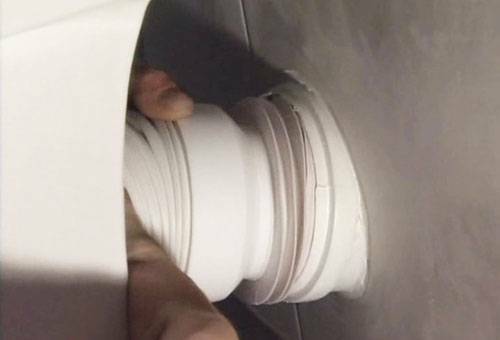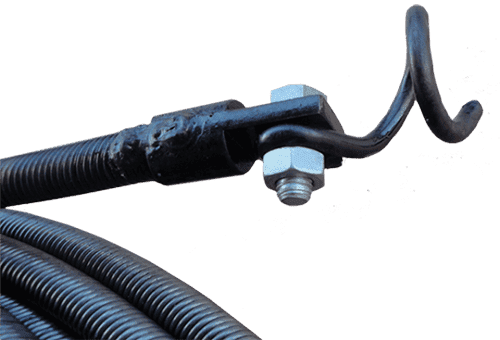Contents:
- Is it always possible to get a fallen object?
- Method # 1
- Method # 2
- Method # 3
- How to get a ring or ear ring from the toilet bowl?
- How to get a ring with a plumbing cable?
- To not have to search for
What if the jewelry or costume jewelry accidentally fell into the sink or toilet bowl? After all, sometimes jewelry is expensive not only for its value, but as a symbol of relationships or a gift of an expensive person. For example, if a wife drops an engagement ring or an earring presented by her husband, she will be less concerned with the cost: more important in this case is the value of the object that fell.
In case of such trouble, the first thing you need to do is to pull yourself together and try to get the fallen object yourself. The article will give step-by-step instructions on how to do this. If none of the methods work, it's still too early to get upset. In this case, you can invite plumbing - perhaps, he will be able to find a "loss".
advice If an earring or other object falls into the sink, do not allow a new portion of water to drain. The decoration can not fall into the sump, but it will catch on to the roughness of the pipe. A new stream of water in this case will wash it off, and it will not be possible to get the jewelry.

Is it always possible to get a fallen object?
It's impossible to say with certainty that the ring or the earring is in the pipes of the apartment, and did not go free swimming to the city sewer. But there are several factors that increase the chances of a happy outcome:
- the object fell into a bath or washbasin, under which there is a siphon;
- the bottom of the siphon is not clogged;
- to the common drain pipe goes the corrugated hose;
- after the decoration fell into the sink, there was no strong drainage of water;
- in a bath or toilet bowl fell a large object, such as a bracelet.
But even if from the washbasin to the drain goes a straight pipe without a knee( and this also occurs), the outcome can be successful - the earring can catch on the calcareous deposits on the pipe, and it will be possible to get it. Here you can only say: "do not see - do not know, do not try - do not understand."So we turn to the ways of getting the fallen jewelry. There are several of them. The first three are suitable only for the washbasin, bath and shower. But there are also techniques that will help get hold of the jewelry that fell into the toilet.

Method no. 1
This method is suitable only if the mesh holder is on top. If you have such a design of the washbasin, this will greatly simplify the task. In order to remove the mesh, depending on the type of screw, you may need a flat( with a straight slot) or a crosshead screwdriver of the appropriate size. Usually the connecting screw is 6-8 mm in diameter.
In addition to a screwdriver, you will need a piece of wire. It needs to be bent in such a way that the bottom turns a hook, and along the length it reaches the bottom of the siphon. Then it remains to unscrew the connecting screw. If it is made of poor-quality material, oxidized and "boiled", then it must be sprayed with WD-40 spray or well moistened with kerosene. After the grid is removed, you can shine a flashlight in the drain( provided that the pipe is placed perpendicular to the sink) - perhaps the decoration was stuck just outside the hole.
Advice
The bent end of the hook should not be sharp if searches are conducted in plastic pipes.
If you can not see it, you should not be upset either - it may have fallen under a layer of lighter litter. In this case it remains methodically crocheted to "inspect" the pipe and siphon, along the way pulling out the garbage collected there. In most cases at this stage, the ring or earring returns to its owner and it remains only to put the grille in place, tightening the connecting screw. At the same time, you need to make sure that the rubber band is in place and does not move during the tightening, otherwise the washbasin will leak. Sometimes replacement of the sealant is required and additional sealing with a sealant.

Method number 2
This method is also not suitable for everyone, since it assumes the presence of a washing vacuum cleaner. But if such an aggregate is in the house - you can start squeezing the object that fell.
For this you need to perform a number of actions.
- Remove the nozzle from the pipe.
- Put a piece of gauze or a kapron toe on the end of the pipe( piece of pantyhose), fixed with an elastic band.
- Press the vacuum cleaner tube against the drain hole. If possible, then remove the grate.
- Switch on the vacuum cleaner for 1-2 minutes. Before switching off, first take the pipe to the side, and only then turn off the vacuum cleaner. If done in the reverse order - the ring will again fall into the drain.
- If the ring has not risen - clean the gauze from the adhered debris and repeat the procedure again.
The peculiarity of this method is that it will help only if the loss is stuck at a distance of no more than 7 cm. If the decoration has fallen deeper, the vacuum cleaner's power will not suffice to lift it.
Advice
Do not use a normal vacuum cleaner or a vacuum cleaner with a water filter for such operations. If water gets into their motor, then breakage of such equipment is guaranteed. Pre-pumping water with rubber pears or syringes does not always ensure complete dryness. Water can remain in the horizontal tube, and then get into the vacuum cleaner.

Method number 3
The most versatile way is to remove the sump trap. In this case, the object dropped into the washbasin simply drops out. The sump is located at the bottom of the siphon, on a bend.
The disassembly is carried out as follows.
- First you need to replace the siphon with a bucket.
- Then unscrew the nut with the gasket holding the siphon cap.
- After removing the lid, the accumulated debris will be poured into the bucket and the remaining water in the sink will flow out. Among the garbage dropped and you need to look for the lost ring.
- If the decoration is not found, you should carefully inspect the side walls of the siphon and check the adjacent pipe with a thin stick - maybe it's stuck there.
If the siphon does not show any loss, it's time to call for plumbing. He will disassemble the sink of the sink, remove the siphon and lead to the sewer pipe. In this case, if the decoration is not washed off into the public sewer system, it will certainly be found.

How to get a ring or earring from the toilet bowl?
In order to get an object that falls into the toilet, you will need rubber gloves( long).In case the ring accidentally fell into the toilet, you first need to cut off the water in the apartment( or do not use water).This is done so that the water that merges along the adjacent pipes does not change the water level in the toilet. And, of course, while the search works are on, the toilet can not be used.
The easiest way is to put on gloves and, putting your hand deeper, try to grope decoration. If, however, it was carried by the pressure of water into a branch pipe connecting the toilet bowl and the sewer riser, then it is necessary to remove it - there is a chance that the earring is there. This probability is especially great if the tap is a corrugated pipe. To remove the challenge, it is better to invite a specialist or to ask someone who is versed in the plumbing.
When removing corrugations, one must take into account one nuance. Usually it is first taken out of the toilet outlet, and then from the sewer pipe. This is done in order to drain the sewerage of the remains of water. If the task is to find the object that got there in the pipe, then the sequence must be reversed - first the corrugation is taken out of the sewer pipe, and then out of the outlet. The remaining water in the corrugated water must be drained in a bucket: perhaps, along with the water, an ornament will fall out. If this did not happen, then you need to carefully check the pipe and climb into the toilet on the side of the outlet. Usually at this stage, the decoration returns to its owner.

How to get the ring with a plumbing cable?
The plumbing cable is almost the only way out if the decoration fell into the toilet with a cast iron tap or directly connected to a common riser. It can also be used when the object fell into the drain of a bath or washbasin with cast-iron pipes and a siphon. This method is rather risky, and it is necessary to apply it only when there is no other way to get the jewelry. The fact that the end of the cable can hook on the jewelry, and it can be obtained or pushed it further - into the public sewer.
If there is no other way out and you decide to take a risk, you need to do the following.
- Find a plumbing cable with a hook or rope-type cable with a broken tip - a tip in the form of a brush.
- Start the end of the cable in the toilet bowl or drain the tub until it stops.
- Turn the handle in one direction until the cable goes further.
- If the cable rested again - you need to get it and see, maybe the jewelry has already caught on. If not - clean the tip of the dirt and continue on.
Tip
Neither manual nor pneumatic plunger is used to catch ornaments from the sink is not recommended. The task of the plunger is not to deflate the water and debris, but to move it and push it further.

So as not to have to look for
The loss of jewelry and jewelry in plum plumbing happens very often. And this is not due to women's inattention, but for a number of quite understandable reasons. Water and detergents make the surface of the hand and fingers slippery, so even a tightly seated ring or bracelet can easily slip off, even unnoticed by the landlady. Earrings often fall, unfastening when washing.
To avoid such situations, you can purchase inexpensive devices. This is a plastic grid with small cells in the kitchen sink or a fine mesh net on the sink. Plastic mesh is installed over the main drain mesh, and it can be cleaned at any time. Such a small and inexpensive detail will save you from losing precious things to your heart.



